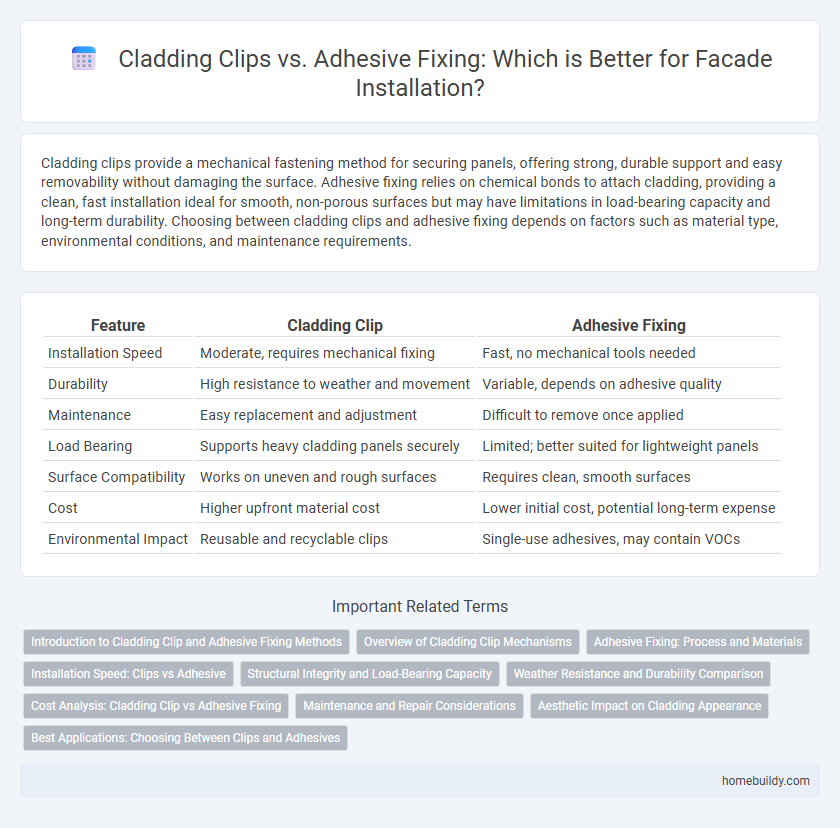Cladding clips provide a mechanical fastening method for securing panels, offering strong, durable support and easy removability without damaging the surface. Adhesive fixing relies on chemical bonds to attach cladding, providing a clean, fast installation ideal for smooth, non-porous surfaces but may have limitations in load-bearing capacity and long-term durability. Choosing between cladding clips and adhesive fixing depends on factors such as material type, environmental conditions, and maintenance requirements.
Table of Comparison
| Feature | Cladding Clip | Adhesive Fixing |
|---|---|---|
| Installation Speed | Moderate, requires mechanical fixing | Fast, no mechanical tools needed |
| Durability | High resistance to weather and movement | Variable, depends on adhesive quality |
| Maintenance | Easy replacement and adjustment | Difficult to remove once applied |
| Load Bearing | Supports heavy cladding panels securely | Limited; better suited for lightweight panels |
| Surface Compatibility | Works on uneven and rough surfaces | Requires clean, smooth surfaces |
| Cost | Higher upfront material cost | Lower initial cost, potential long-term expense |
| Environmental Impact | Reusable and recyclable clips | Single-use adhesives, may contain VOCs |
Introduction to Cladding Clip and Adhesive Fixing Methods
Cladding clips provide a mechanical fixing method that securely attaches panels to structural frameworks, offering stability and ease of installation without damaging materials. Adhesive fixing relies on strong bonding agents to adhere cladding panels directly to surfaces, ensuring a seamless appearance with reduced thermal bridging. Both methods impact the durability, maintenance requirements, and aesthetic outcomes of exterior cladding systems in construction projects.
Overview of Cladding Clip Mechanisms
Cladding clip mechanisms provide secure, mechanical attachment for facade panels, ensuring durability and ease of installation compared to adhesive fixing methods. These clips often feature interlocking systems designed to accommodate thermal expansion and weather resistance while maintaining structural integrity. Unlike adhesives, cladding clips allow for easier panel replacement and provide ventilation gaps that reduce moisture buildup and prolong facade lifespan.
Adhesive Fixing: Process and Materials
Adhesive fixing for cladding involves applying specialized construction adhesives such as polyurethane or silicone-based products, which offer high bond strength and weather resistance. The process requires thorough surface preparation to ensure cleanliness and dryness, followed by precise adhesive application and cladding panel placement, allowing for uniform load distribution and thermal expansion accommodation. Compared to mechanical cladding clips, adhesive fixing provides a seamless finish with reduced thermal bridging, though careful material compatibility assessment is essential to maintain long-term durability and structural integrity.
Installation Speed: Clips vs Adhesive
Cladding clips offer significantly faster installation compared to adhesive fixing, reducing labor time by up to 40%. The mechanical fastening of clips eliminates curing time required for adhesives, enabling immediate panel adjustment and alignment. This efficiency makes cladding clips ideal for large-scale projects where speed and precision are critical.
Structural Integrity and Load-Bearing Capacity
Cladding clips provide superior structural integrity and load-bearing capacity compared to adhesive fixing by mechanically anchoring panels to the building frame, ensuring stability under dynamic loads such as wind and seismic activity. Adhesive fixing, while offering a clean aesthetic, typically lacks the long-term durability and resistance to environmental stresses that mechanical clips deliver. The use of cladding clips enhances safety and longevity, making them the preferred choice for high-rise and commercial facade systems requiring robust load distribution.
Weather Resistance and Durability Comparison
Cladding clips offer superior weather resistance compared to adhesive fixing by providing mechanical fastening that withstands wind loads, temperature fluctuations, and moisture infiltration without degradation. Unlike adhesives, which can lose their bonding strength due to UV exposure and humidity over time, cladding clips maintain structural integrity and prevent panel displacement. This durability advantage makes cladding clips the preferred choice for long-term exterior facade applications requiring reliable performance in harsh environmental conditions.
Cost Analysis: Cladding Clip vs Adhesive Fixing
Cladding clips typically offer a lower long-term cost compared to adhesive fixing due to their durability and ease of maintenance, reducing replacement and repair expenses. While adhesive fixing may have a lower initial installation cost, it often requires more frequent inspections and potential reapplication, increasing overall project expenditure. Factoring in labor, material longevity, and maintenance needs, cladding clips provide a more cost-effective solution for sustainable building facade installations.
Maintenance and Repair Considerations
Cladding clips offer superior ease of maintenance and repair compared to adhesive fixing, enabling individual panels to be removed and replaced without damaging adjacent sections. Unlike adhesives that may degrade over time and complicate repairs, clips provide durable mechanical fastening that simplifies inspection and prolongs facade lifespan. This system minimizes downtime and reduces the total cost of ownership through straightforward access and secure reattachment.
Aesthetic Impact on Cladding Appearance
Cladding clips provide a discreet and uniform attachment method, preserving the clean lines and seamless appearance of the facade without visible fasteners. Adhesive fixing, while eliminating mechanical components, can lead to uneven edges or potential staining over time, affecting the aesthetic integrity of the cladding surface. The precision and consistent alignment achievable with cladding clips enhance the overall visual appeal by maintaining a smooth and professional finish.
Best Applications: Choosing Between Clips and Adhesives
Cladding clips provide superior mechanical fastening ideal for heavy or large panels, ensuring durability and easy maintenance in exterior facades. Adhesive fixing excels with smaller, lightweight materials where a clean, hidden attachment is preferred, enhancing aesthetic appeal without visible fasteners. Selecting between clips and adhesives depends on factors like panel size, weight, environmental exposure, and the need for future removability or adjustments.
Cladding clip vs Adhesive fixing Infographic

 homebuildy.com
homebuildy.com